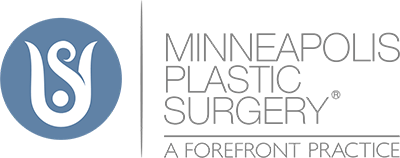Abdominoplasty (Tummy Tuck)
After childbirth or weight loss, the abdominal area often has loose or sagging skin, and may also exhibit stretching of the abdominal wall muscles or fascia (the tough gristle-like layers that surround the abdominal wall muscles and give the area strength). This stretching of the rectus sheath or fascia that surrounds the rectus abdominis muscles is termed diastasis recti. There may also be hernias (bulges of intra-abdominal contents such as intestines and fat through tears or openings) in the abdominal wall. These can be tiny asymptomatic bulges, such as those that commonly occur in the umbilicus, or they can be large enough to cause strangulation of the sections of the small bowel which protrude and become caught in the hernia. The latter is rare and dangerous, the former, common and unsightly. Generalized weakness and protrusion of the abdomen with loose overlying skin that often has visible stretch marks (striae) are the hallmarks of patients who need abdominoplasty, or “tummy tuck.” Liposuction in this setting is the wrong choice, and often leaves irregular and “deflated-appearing” wrinkled skin such as in the “Before” photo (case 2) below. Liposuction is NOT the proper operation for a patient with loose skin and stretched abdominal wall musculature.
See Before and After Images in our Tummy Tuck Gallery!
Abdominoplasty removes loose skin, tightens the abdominal wall muscles, and repairs any hernias found. Skin “stretch marks” (striae) are commonly seen in patients who have had hormone changes accompanied by mechanical skin stretching such as with pregnancy or growth spurts during puberty. Stretch marks cannot be effectively treated except by surgical excision (removal) of the affected skin, such as with a tummy tuck. Any stretch marks above the umbilicus cannot be removed, but will be repositioned to the suprapubic lower abdomen with abdominoplasty. Minneapolis Plastic Surgery, LTD. offers the tummy tuck procedure (abdominoplasty) to appropriate women (and men) who can be improved by this operation.
Candidates for Abdominoplasty
If you have loose, wrinkled, or sagging abdominal skin, no amount of exercise will restore the lost elasticity and collagen content in that stretched skin. The same goes for the stretched abdominal wall fascia (diastasis recti)—sit-ups and crunches can give you “abs of steel,” but they will still be separated from each other by the stretched fascia that gives you an abdominal “pouch.”
Abdominoplasty is the only answer for this concern. The good news is that other areas of localized fatty tissue, such as the hips (“muffin top” or “love handles”), lateral thighs (“saddlebag” area), or other areas, can be treated with liposuction at the same time as abdominoplasty. If the loose skin continues to the hips, thighs, and buttocks, extended abdominoplasty, or even complete circumferential belt lift, “360 tummy tuck,” or lower body lift, can be performed.
Some patients may have tight abdominal skin but still have localized subcutaneous fatty tissue outside the abdominal wall; these patients may be candidates for suction-assisted lipoplasty (liposuction). Other patients, including some men with round or protruding abdominal areas and little fat outside the abdominal wall, are not candidates for abdominoplasty or liposuction, since their excess fat weight is carried inside the abdomen (mesentery and omentum) and will respond only to diet and exercise. Good candidates for abdominoplasty include:
- Women after pregnancy who do not plan to become pregnant again
- Men or women who have undergone significant weight loss
- Those with loose or sagging abdominal skin due to aging or genetics
Procedure
After careful assessment of the location and extent of your skin laxity, Dr. Richard H. Tholen or Dr. Douglas L. Gervais will mark the planned incisions and any fatty areas to be addressed at the time of your operation. The abdominoplasty scars are usually just above the pubic area (and around the belly button), and in most patients fade nicely over time. The scars are usually concealed by normal swimwear and clothing choices. In addition to excess skin removal and tightening, abdominoplasty and abdominal contouring include tightening of the abdominal wall muscles with several layers of suture—restoring the abdominal fascia and its contour to their pre-pregnancy or pre-stretched state. This usually results in flattening of the abdomen and a loss of one or more belt or dress sizes!
Both Dr. Gervais and Dr. Tholen perform abdominoplasty, abdominoplasty plus liposuction (abdominal contouring), and other forms of body contouring such as circumferential belt lift (lower body lift), thigh lift, breast lift, and arm lift (brachioplasty), all in our nationally-accredited (AAAASF) on-site surgical facility on an outpatient basis. Abdominoplasty (tummy tuck) is made as comfortable as possible for our patients with our superior anesthesia and surgical techniques. Abdominoplasty is often combined with breast augmentation or breast lift, as these areas are also commonly affected after childbearing and/or breastfeeding. Abdominoplasty, breast surgery (augmentation, lift, or lift plus implants), plus liposuction in selected patients, is commonly known as a “mommy makeover.”
Recovery and Results
Most patients undergoing abdominoplasty or abdominal contouring will require one or two small surgical drainage tubes beneath the skin to evacuate fluid or blood that may collect after this surgery. To minimize drainage as well as bleeding, it is essential that every patient avoid aspirin, ibuprofen, Aleve™, vitamin E (the amount in a daily multivitamin is OK), or herbal preparations for a minimum of two weeks prior to surgery. The drain(s) remain in place until drainage is reduced to less than an ounce of fluid per drain per day. Drain removal is simple and is carried out at a routine recheck visit without anesthesia or sutures. While drains are in place, and for at least two to three weeks after surgery, an abdominal binder or compression garment will need to be worn to assist the tissues in healing in their new tightened positions. The belly button remains in exactly in the same place it was when you were born—just with a new opening for it in the tightened skin that has been brought down around it. Except for the drain stitch and a few tiny sutures around the belly button, all sutures are below the skin surface, leaving no cross-hatch or suture marks and yielding the best scar possible when fully healed.
There will be numbness in the lower abdominal skin after surgery; most, but not all, sensation returns as the sensory nerves re-grow in the ensuing months. Strenuous activities should be limited after this kind of surgery for at least two weeks, and no sit-ups or abdominal crunches should be performed for at least six weeks. Most other activities are resumed quickly, and most patients return to social activity and work after one to two weeks, or after drain removal.
Because abdominoplasty, abdominal contouring, and more extensive operations such as extended abdominoplasty or belt lift all lift, remove, and tighten skin, adequate circulation to the skin flaps is necessary for proper healing and minimal scarring. In nonsmokers, circulation problems that can impair healing and increase scarring occur in less than one to two percent of patients. Smoking just one cigarette, using nicotine gum or patches, or even exposure to second-hand smoke can raise the risk of developing dead skin or a dead belly button to as much as 15-20 percent. For this reason, the use of all tobacco and nicotine products must be stopped completely at least two weeks before surgery, and they must be avoided after surgery until all things are healed. Failure to comply with this requirement will result in the cancellation of your surgery; concealing your own failure to follow this requirement may result in dead skin and prolonged dressing changes, skin grafts, or additional surgery to deal with scarring.
Fortunately, abdominoplasty and abdominal contouring are among the most common plastic surgical procedures we perform; Dr. Gervais and Dr. Tholen conduct well over 100 of these operations for Minneapolis / St. Paul area patients per year. Most patients are thrilled with their results. A complimentary consultation can help you determine what procedure or procedures are best suited for your own concerns.
Cost of Tummy Tuck (Abdominoplasty)
Abdominoplasty cost is determined on and individual basis, depending on the amount of tissue to be removed, the length of the incision, whether muscle repair is needed (almost always) or if umbilical or other hernias are present, whether liposuction is utilized, and the length of operating room and anesthesia time needed to optimally perform these steps. Many women also add breast surgery or other surgical procedures at the time of tummy tuck. Exact costs (not estimates) are given at the time of consultation with our plastic surgeons, after your goals are addressed and individualized examination and assessment allows a surgical plan to be tailored uniquely to you.
For a slim petite woman who has only loose abdominal skin and moderate diastasis of her abdominal wall muscles (stretch of the fascial layers that surround the 6-pack muscles, usually from pregnancy or after weight loss), and needs no additional liposuction, abdominoplasty including muscle repair might require 2 ½ hours in the operating room, with a total cost (surgeon’s professional fee including no-charge consultation and all follow-up visits, operating room, anesthesia, and compression garment) of about $13000.
Total cost for an extended tummy tuck taking 3 hours will be about $14000.
Patients who require more skin removal, liposuction of the upper abdomen, hips, or flanks, will require longer operating room times and increased costs. Exact price quotes are given based on these individual factors, and are received in writing at the time of consultation. There is never pressure to decide, cost quotes are valid for 6 months, and financing options are available, if you wish.
We are absolutely sure that you can find lower-cost procedures elsewhere, some by non-ABPS certified plastic surgeons who call themselves “cosmetic surgeons,” or by surgeons who have not sub-specialized in aesthetic plastic surgery. You can also find surgeons who charge more for the same operations, usually in an attempt to take advantage of the patient who thinks highest cost equals highest quality. While that can be true is some settings and situations, it can also simply be a “cover” for average work masquerading as “something special.”
At Minneapolis Surgery, LTD. you will receive the highest-quality and most cost-effective aesthetic plastic surgery we are capable of providing, in our confidential on-site nationally-accredited (AAAASF) surgical facility, with a staff dedicated to your safety, confidentiality, and optimal outcome. Contact us for a no-charge consultation before you decide.
Because of the high demand for free consultations with our plastic surgeons, our staff will ask for a credit card number in order to schedule a consultation; there is no charge whatsoever for appointments that are kept–you will be charged $100 only if you fail to keep a scheduled appointment, or fail to cancel at least 48 hours in advance of your appointment time–for Monday appointments, you must cancel no later than noon on the previous Thursday; for Tuesday appointments, you must cancel by noon on the previous Friday.

